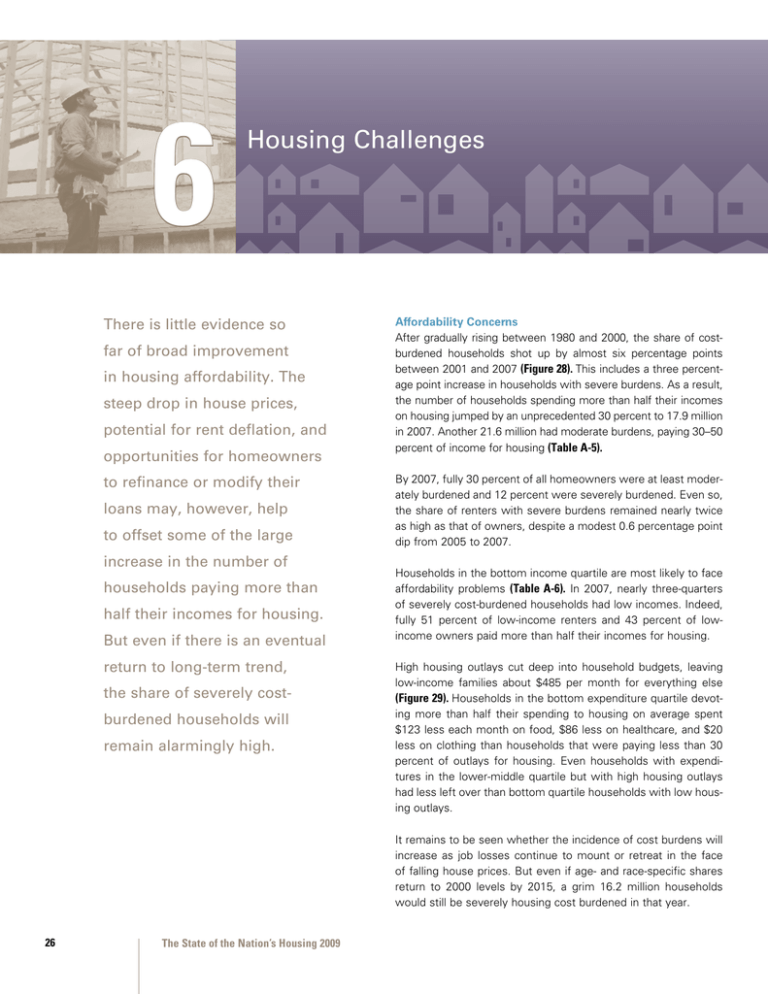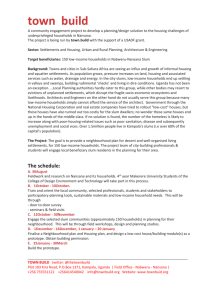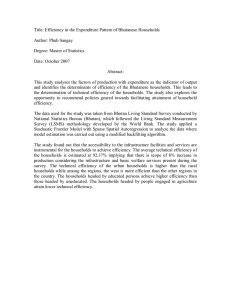6 Housing Challenges There is little evidence so far of broad improvement
advertisement

6 Housing Challenges There is little evidence so far of broad improvement in housing affordability. The steep drop in house prices, potential for rent deflation, and opportunities for homeowners to refinance or modify their loans may, however, help to offset some of the large increase in the number of households paying more than half their incomes for housing. But even if there is an eventual return to long-term trend, the share of severely costburdened households will remain alarmingly high. Affordability Concerns After gradually rising between 1980 and 2000, the share of costburdened households shot up by almost six percentage points between 2001 and 2007 (Figure 28). This includes a three percentage point increase in households with severe burdens. As a result, the number of households spending more than half their incomes on housing jumped by an unprecedented 30 percent to 17.9 million in 2007. Another 21.6 million had moderate burdens, paying 30–50 percent of income for housing (Table A-5). By 2007, fully 30 percent of all homeowners were at least moderately burdened and 12 percent were severely burdened. Even so, the share of renters with severe burdens remained nearly twice as high as that of owners, despite a modest 0.6 percentage point dip from 2005 to 2007. Households in the bottom income quartile are most likely to face affordability problems (Table A-6). In 2007, nearly three-quarters of severely cost-burdened households had low incomes. Indeed, fully 51 percent of low-income renters and 43 percent of lowincome owners paid more than half their incomes for housing. High housing outlays cut deep into household budgets, leaving low-income families about $485 per month for everything else (Figure 29). Households in the bottom expenditure quartile devoting more than half their spending to housing on average spent $123 less each month on food, $86 less on healthcare, and $20 less on clothing than households that were paying less than 30 percent of outlays for housing. Even households with expenditures in the lower-middle quartile but with high housing outlays had less left over than bottom quartile households with low housing outlays. It remains to be seen whether the incidence of cost burdens will increase as job losses continue to mount or retreat in the face of falling house prices. But even if age- and race-specific shares return to 2000 levels by 2015, a grim 16.2 million households would still be severely housing cost burdened in that year. 26 The State of the Nation’s Housing 2009 Housing Conditions Unlike cost burdens, the incidence of poor-quality housing declined between 2001 and 2007. Nonetheless, about one in ten households in the bottom income quartile lived in inadequate housing in 2007. Moreover, poor quality is no guarantee of affordability. Nearly half of the low-income households living in inadequate units also paid more than 50 percent of their incomes for their housing. Figure 28 Affordability Problems Surged During the Housing Boom Share of Households with Cost Burdens (Percent) 20 19 18 17 16 15 14 13 12 11 10 1980 � 1990 2000 Severe Cost Burdens � 2001 2003 2005 2007 Moderate Cost Burdens Note: Severe (moderate) housing cost burdens are more than 50% (30–50%) of pre-tax household income. Sources: JCHS tabulations of the US Census Bureau, 1980–2000 Decennial Censuses and 2001–7 American Community Surveys. The problem of crowding also eased somewhat in 2001­–7, with the number of households living in homes with more than one person per room dropping from 2.8 million to 2.6 million. Overall, only 2.3 percent of US households were crowded in 2007. In the near term, however, recession-induced job losses and foreclosures may force more families to double up temporarily with relatives or friends. The recession may also erase recent progress in reducing homelessness. A January 2007 count put the number of homeless at 671,888—marking a 10 percent drop in total homelessness and a heartening 28 percent reduction in chronic homelessness since 2005. This turnaround reflects in part the addition of roughly 70,000 units of supportive housing from 2002 to 2007. Still, deinstitutionalization in the 1980s created a more or less permanent shelter population that persists today. About 1.6 million people used emergency homeless shelters or transitional housing over the course of 2007. Two-fifths of the homeless were sleeping on the street or in other places unfit for human habitation. More than a third of the homeless were members of families with children. In the fall of 2008, some 16 of the 22 cities responding to a US Conference of Mayors survey reported increases in homelessness, indicating that the recession was already having a negative impact. Employment Pressures Job losses have risen at a stunning pace, and many workers who are still employed have seen cuts in hours and income. For those Figure 29 High Housing Outlays Sharply Reduce Household Spending on Other Necessities Average Monthly Spending (Dollars) Households in the Bottom Expenditure Quartile Households in the Lower-Middle Expenditure Quartile Food Food Transportation Transportation Healthcare Healthcare Insurance and Pensions Insurance and Pensions Clothes Clothes 0 � 100 200 With Low Housing Outlays 300 � 400 500 600 0 100 200 300 400 500 600 With High Housing Outlays Notes: Expenditure quartiles are equal fourths of all households based on total expenditures. Households with high (low) housing outlays devoted 50% or more (under 30%) of total expenditures to housing. Source: JCHS tabulations of the 2007 Consumer Expenditure Survey. Joint Center for Housing Studies of Harvard University 27 who become unemployed, the loss of income far outweighs any improvement in housing affordability from falling house prices or rents. Until labor markets start to recover, more and more households will struggle to make ends meet. Prospects for a near-term rebound in jobs are poor. Employment growth usually lags economic upturns, and job recovery has progressively slowed in recent decades. Following the recessions that occurred between 1948 and 1980, employment regained previous peaks in less than two years. In contrast, job recovery took 28 months in the early 1980s, 32 months in the early 1990s, and a full 48 months in the early 2000s. As of the end of April 2009, unemployment had hit 8.9 percent— an increase of four percentage points from the beginning of the recession—and sidelined 5.7 million workers. Nearly half of those jobs were lost in just the first four months of this year. And these figures do not include the 8.9 million workers who involuntarily worked part-time or the 2.1 million who wanted jobs but had But the unemployed who are seeking work make up only a small fraction—just one in 15—of householders with severe burdens (Figure 30). In fact, nearly half were working in 2007. One out of five severely burdened householders was retired, while one out of ten was non-elderly disabled. Regardless of employment status, the vast majority of severely burdened householders have low incomes. The possibility that households with low-wage workers can earn their way out of their housing affordability problems is small. In 2007, low-wage service workers in four occupational groups— personal services, cleaning and maintenance services, food services, and healthcare support—were the most likely to have severe housing cost burdens (Figure 31). The Bureau of Labor Statistics predicts that the majority of employment growth from 2006 to 2016 will be in low-paying service and in high-paying professional occupations. Fragile Family Finances How households that suffer loss of income weather the recession depends on their assets, debt levels, fixed costs, and ability to borrow. Unfortunately, the collapse of house and stock prices wiped out most of the gains in household wealth from the bubble years. And going into the recession, many families were already stretched thin by heavy borrowing. Aggregate household debt roughly doubled in real terms between the mid-1990s and the $14.3 trillion peak in 2007, with mortgage debt rising much faster than consumer debt. Figure 30 Many Severely Burdened Householders Are Employed, Retired, or Disabled Share of Householders Paying More than 50% of Income for Housing (Percent) 15% 9% given up the search. This brought the share of unemployed and underemployed workers in April to a record 15.8 percent. 16% 18% 6% 3% 3% 1% 1% 28% Low-Income Low Income Householders � Employed � All Other Householders Unemployed and Seeking Work � Retired � Non-Elderly Disabled � Other Non-Working Notes: Employed householders worked, and unemployed householders looked for work, during the week prior to the survey. Retired, disabled, and other non-working householders were not in the labor force. Retired householders were 65 or older while non-elderly disabled and other non-working householders were under age 65. Low-income households are in the bottom fourth of all households sorted by pre-tax household income. Source: JCHS tabulations of the 2007 American Community Survey. 28 The State of the Nation’s Housing 2009 Households were able to increase their debt loads not only because of lax lending standards but also because low interest rates reduced carrying costs. The fraction of household income spent on debt payments thus increased less than the overall level of debt. For homeowners, the share of disposable income spent on mortgages, debt, and other financial obligations rose from 15.9 percent in 2001 to 18.2 percent in 2007 before turning down in 2008. For renters, the share actually fell from 31.3 percent in 2001 to 26.3 percent in 2007. These aggregate figures, however, mask the sharp run-up in debt among some families. In 2001–7, the share of homeowner families with debt that spent more than 40 percent of their incomes on debt payments climbed 3.3 percentage points, to 18 percent. Homeowners added to the precariousness of their balance sheets by taking on more mortgage debt when home values were soaring. They also added to the risk that a spell of unemployment or a major medical problem could bring financial disaster. Indeed, after declining in 2005 when laws were amended, bankruptcy filings have risen steadily since. In 2008 alone, bankruptcies were up 31 percent from a year earlier, with 1.1 million individuals filing for protection. Figure 31 Workers in Low-Wage Occupations Are Most Likely to Live in Severely Burdened Households Share of Workers Living in Households Paying More than 50% of Income for Housing (Percent) According to a 2007 survey by the Consumer Bankruptcy Project, more than half of bankrupt homeowners with mortgages missed payments before filing, and roughly a quarter said that higher mortgage payments contributed significantly to their bankruptcy. Moreover, 30 percent of homeowner respondents stated that the main reason for filing was to try to save their homes. Of those who had borrowed against their homes to consolidate debt, 28 percent indicated that their mortgage payments had increased beyond what they could afford compared with only 17 percent of those who had borrowed against their equity for other reasons. Personal Services Cleaning Food Services Healthcare Support Construction Sales Office Work Manufacturing Education Business Law All Occupations 0 2 4 6 8 10 12 14 16 Median Personal Income � $10–19,999 � $20–29,999 � $30–49,999 � More than $49,999 Note: Workers are those age 16 or older who worked in the week prior to the survey. Source: JCHS tabulations of the 2007 American Community Survey. Figure 32 Even Controlling for Income, Foreclosures Are Markedly Higher in Minority Neighborhoods Median Estimated 18-Month Foreclosure Rate (Percent) 9 8 7 6 5 4 3 2 1 0 Low Income Moderate Income High Income Census Tracts � Minority � Mixed � White Notes: Minority census tracts were more than 50% minority in 2000; mixed census tracts were 10–50% minority; white census tracts were less than 10% minority. Low-/moderate-/high-income census tracts had median family incomes less than 80%/80–120%/more than 120% of the metropolitan area median. Estimates are based on a HUD model of the share of loans foreclosed from January 2007 to June 2008. Source: JCHS tabulations of HUD 2008 Neighborhood Stabilization Program data and US Census Bureau, 2000 Decennial Census. 18 While bankruptcy discharges most forms of debt and other obligations, mortgage liens are a notable exception. If borrowers are employed and have incomes, they may be able to use Chapter 7 bankruptcy to free up enough income to keep their homes. In contrast, Chapter 13 bankruptcy allows owners facing foreclosure to stay in their homes by committing to a court-ordered repayment plan. In the past, bankruptcy has often delayed but not prevented foreclosure proceedings. Race Matters While the recession has touched almost all households, minorities have been hit especially hard for several reasons. First, they have higher unemployment rates than whites, as well as higher job losses during economic downturns. For example, when the national unemployment rate peaked at 10.8 percent following the 1982 recession, joblessness among black workers was nearly twice as high at 20.9 percent. In April of this year, the unemployment rate was 15.0 percent for blacks and 11.3 percent for Hispanics, compared with 8.0 percent for whites. Second, high-cost (subprime) loans and foreclosures are heavily concentrated in low-income minority neighborhoods. HUD estimates indicate that the median share of high-cost loans issued between 2004 and 2006 in low-income minority census tracts was nearly one-half, while the median share in low-income white neighborhoods was one-third. In addition, the median foreclosure rate from January 2007 through June 2008 was 8.4 percent in low-income minority neighborhoods—significantly higher than the 6.3 percent in low-income white neighborhoods (Figure 32). Third, minority households are twice as likely as whites to be poor. Roughly two in ten minority households had poverty-level incomes in 2007, compared with one in ten white households. Joint Center for Housing Studies of Harvard University 29 Even so, poor white households (7.4 million) still outnumbered poor minority households (6.4 million) in that year. The poverty rate for households headed by blacks was 23 percent and by Hispanics 20 percent. Moreover, 24 percent of minority households were severely housing cost burdened in 2007, compared with just 13 percent of white households. Crisis Responses As the economy slowed, state and local governments faced the dual challenges of falling revenues and rising demand for services. Most governments are required to close budget gaps by increasing taxes, cutting spending, or drawing down reserves. According to a study by the Center for Budget and Policy Priorities (CBPP), in February 2009 state governments were anticipating a collective revenue shortfall of $99 billion for the fiscal year ending July 2009. Combining budget cuts made early in the fiscal year and additional revenue shortfalls reported later on, this amounted to 15 percent of state budgets. Assuming no help from the federal government, the CBPP projected a cumulative state budget gap of $350 billion through the end of fiscal 2011. As a result, many states have had to slash social services just as need is growing. Food stamp caseloads—an indicator highly correlated with poverty—increased by 4.2 million or 15.3 percent between December 2007 and December 2008. By May 2009, at least 19 states had implemented cuts in healthcare funding for low-income families and children, while at least 21 had reduced funds for services for the elderly and disabled. To address these problems and bolster the economy, the federal government passed a stimulus package in February that included $142 billion for protecting the vulnerable and $144 billion for state and local government fiscal relief. The bill temporarily increased unemployment and food stamp benefits, and made more funds available to states for cash assistance and homelessness prevention. Also included were significant funds for the repair, rehabilitation, and production of low-income housing, with $4 billion specifically allocated to public housing and $2.25 billion to the Low Income Housing Tax Credit program. The federal government also moved to stabilize pricing in the LIHTC program after demand for tax credits dried up in the face of softening housing markets and skyrocketing losses at large banks, Fannie Mae, and Freddie Mac. Lower prices for tax credits mean fewer affordable units produced for the same government outlay. The stimulus bill attempted to set a floor under prices, offering to exchange any unused 2008 tax credits, and up to 40 percent of competitively allocated 2009 tax credits, at a rate of 85 cents on the dollar. But these measures were designed to maintain LIHTC production only at historical levels, which have neither kept pace with affordable rental demand nor offset losses of affordable units from the subsidized and unsubsidized stock. Figure 33 Improving the Efficiency of the Older Housing Stock Could Generate Substantial Energy Savings Potential Decrease from 2005 Levels (Percent) 25 20 15 Federal funding for direct rental assistance has been declining or unstable in recent years. As of 2008, 4.7 million renters—roughly a quarter of those eligible—received such assistance (Table W-9). Moreover, spending on low-income housing as a share of the domestic discretionary budget has fallen more than 20 percent since 1995. The current administration has, however, called for an increase in funding for rental housing vouchers and a set-aside of $1 billion for an affordable housing trust to pay for development and preservation of units for the nation’s neediest households. 10 5 0 Updating to 1980–9 Efficiency � Updating to 1990–9 Efficiency Residential Energy Consumption � Updating to 2000–5 Efficiency Total US Energy Consumption Note: Potential decrease is the energy that would be saved annually if the older stock consumed the same energy per square foot as homes built in the given time periods, controlling for region. Sources: JCHS calculations based on the US Department of Energy, 2005 Residential Energy Consumption Survey, and the US Energy Information Administration, 2007 Annual Energy Review. 30 The State of the Nation’s Housing 2009 Energy and Environmental Concerns The housing sector provides a number of opportunities to address two urgent national goals—reducing greenhouse gases and foreign oil dependence. Today, the residential sector is responsible for about 21 percent of total energy consumption. If homes built before 2000 used as little energy per square foot (adjusted by region) as those built since then, residential consumption would drop by 22.5 percent (Figure 33). While this calculation does not account for differences between older and newer homes related to layout, location, and household behavior, it does illustrate the potential energy savings from retrofitting the existing housing stock. By one recent estimate, shifting 60 percent of future residential development to compact forms could reduce energy consumption by 2030 by the same amount as enacting a 28 percent increase in federal fuel efficiency standards by 2020. While subject to significant uncertainty and assumptions about what constitutes compact development, such estimates do point to the huge potential fuel savings from containing sprawl. Figure 34 Central City Residents Drive Considerably Less than Their Suburban Counterparts Weighted Average Daily Vehicle Miles Traveled by Households 65 60 55 50 45 40 35 30 25 20 15 10 5 0 Central Suburb City Central Suburb City Central Suburb City Central Suburb City Northeast Midwest South West Metro Status and Region � Work-Related Travel � Non-Work Travel Note: Weighted average daily vehicle miles traveled control for differences in the share of households by type and age across locations. Source: JCHS tabulations of the 2001 National Household Travel Survey. While builders have started to embrace green techniques to meet emerging consumer demand, they are also under pressure from building regulations and government procurement standards to do so. Indeed, with the new administration’s commitment to energy efficiency and reduced emissions, federal regulations and programs supporting green building practices and energy-efficient improvements are likely to expand. The upfront costs of achieving significant energy reductions in the existing stock would, however, be hefty. Whether the government will provide significant enough incentives to spark such improvements remains to be seen. Compact, transit-oriented development also holds great promise for limiting energy consumption and carbon emissions. The nation’s population has spread out from urban cores for more than a century. From about 25 percent in 1950, the suburban share of the population mushroomed to more than 50 percent by 2000. This decentralization has contributed to rapid growth in vehicle miles traveled. In 2001, center city households drove 8.9 miles a day for work commutes and 36.6 miles for non-work activities on average, while suburban households drove 12.2 miles for work and 47.8 miles for other trips (Table W-10). Even after controlling for census region, age, and household type, center city dwellers used their cars much less than their suburban counterparts (Figure 34). But implementing compact land use patterns would require much more accommodating state and local regulations. Indeed, many communities now insist on low-density large lot zoning. Furthermore, the long-term decentralization of people and jobs has made it difficult to reverse the growth in the distances that households travel each day. The success of efforts to promote compact development thus depends on creating more densely settled, transit-served, mixed-use communities and on encouraging businesses to expand in or relocate to these areas. The Outlook Stretched thin by overborrowing, job losses, and asset deflation, more and more Americans find themselves at risk of losing their homes. These immediate and fast-spreading challenges come on top of the affordability problems that millions of low-income households already face. For many low-income families, working full time is simply not enough to pay for decent housing at the 30-percent-of-income standard. For many low-income seniors and the chronically unemployed, government transfers are also insufficient to avoid severe cost burdens. Even if home prices and real rents fall further, the improvement in affordability would do little to ease these pressures. Federal efforts to stimulate economic growth, encourage first-time homebuyers to enter the market, lower mortgage interest rates, and stem the tide of foreclosures will have a decisive effect on how long housing takes to recover. Some hopeful signs that the economic decline is slowing have emerged, but downside risks still exist. It is also unclear if the big drop in home prices will change people’s housing investment behavior for an extended period of time. If incomes do not make up for lost ground over the next few years, the ill effects of this severe recession could linger. When the housing market does rebound, demographic forces should restore annual housing production to at least the levels seen in the late 1990s and early 2000s. The aging of the echoboom generation will help to fuel household growth and undergird demand. Nonetheless, future immigration levels remain a wildcard that could either dampen housing demand or lift production even higher. Joint Center for Housing Studies of Harvard University 31





